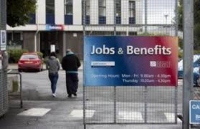Unemployment in Northern Ireland Increases Significantly
Tuesday 26 January, 2021 Written by Simon Collyer
UNEMPLOYMENT Northern Ireland - The number of people on the NI claimant count (experimental) increased over the month to 59,900 in November 2020. This November count is more than double the number recorded in March.
In Summary
The labour market statistics were published today by the Northern Ireland Statistics & Research Agency.
Almost 10,500 redundancies proposed since March
- 11,000 collective redundancies were proposed in the twelve months to the end of December, more than double the number recorded in the previous twelve months. Almost 10,500 were proposed in the ten months since March alone.
- During December, 340 redundancies were proposed, a decrease on the previous month’s total of 1,370, and 440 redundancies were confirmed, a slight increase from the total of 420 confirmed in November.
NI Claimant Count (Experimental Series) decreases over the month
- In December 2020, the seasonally adjusted number of people on the claimant count was 58,400 (6.3% of the workforce), which is a decrease of 1.3% from the previous month’s revised figure and 9.1% below the recent peak in May. The claimant count is currently at levels previously seen in 2012 and 2013.
Payrolled employees and employee earnings increased over the month to November
- The number of employees receiving pay through HMRC PAYE in NI in November 2020 was 740,800, a marginal increase of less than 0.1% over the month and a decrease of 1.1% over the year. The flash estimate for December shows an increase of 0.2% on November’s figure to 742,200.
- Earnings from the HMRC PAYE indicated that NI employees had a median monthly pay of £1,781 in November 2020, an increase of 0.4% over the month and 5.6% from the same time last year. The flash estimate for December shows an increase of 0.7% from November’s figure.
The unemployment rate decreased over the quarter and increased over the year
- The latest NI seasonally adjusted unemployment rate (the proportion of economically active people aged 16+ who were unemployed) for the period September-November 2020 was estimated from the Labour Force Survey at 3.2%. The unemployment rate decreased over the quarter by 0.5 percentage points (pps) and increased by 0.9pps over the year. Although recent changes were not statistically significant, the unemployment rate was significantly above rates at the beginning of 2020.
- The proportion of people aged 16 to 64 in work (the employment rate) decreased over the quarter by 0.1pps and over the year by 2.0pps to 70.6%. Although recent changes were not statistically significant, the employment rate remains significantly above rates in 2017.
- The economic inactivity rate (the proportion of people aged 16 to 64 who were not working and not seeking or available to work) increased over the quarter by 0.4pps and over the year by 1.3pps to 27.0%. Although recent changes were not statistically significant, the economic inactivity rate remains significantly below rates in 2010.
- Put into the context of the UK, NI had the lowest unemployment rate, the lowest employment rate and the highest economic inactivity rate of all the UK regions.
Commentary
- The latest labour market data show that employment remains below pre-covid levels, while measures of unemployment are higher than pre-covid levels.
- Labour Force Survey data for September-November shows the unemployment (3.2%) and employment (70.6%) rates decreased, and the economic inactivity (27.0%) rate increased over the quarter. The September-November economic inactivity and unemployment rates are 1.4pps and 0.7pps above their pre-covid levels (December to February 2020) respectively and the employment rate is 1.9pps below. The majority of the decrease in employment since the start of the year has been due to decreases in the number of self-employed.
The Official Bulletin
During 2020, 11,000 collective redundancies were proposed and 4,700 were confirmed to have taken place; the highest in the last ten years.
The experimental Claimant Count includes Jobseeker’s Allowance Claimants and those claimants of Universal Credit who were claiming principally for the reason of being unemployed.
There were 1,370 proposed redundancies in November 2020 and 340 proposed between 1st and 11th December. From 1st December 2019 to 30th November 2020, 10,720 redundancies were proposed, the highest annual total since records began. The department was notified of 420 confirmed redundancies in November 2020. This takes the number of confirmed redundancies to 4,390 in the 12 months to the end of November.
The number of employees receiving pay through HMRC PAYE in NI in October 2020 was 742,900, an increase of 0.1% over the month and a decrease 0.7% over the year. The flash estimate for November shows an increase of 0.1% on October’s figure to 743,400. • Earnings from the HMRC PAYE indicated that NI employees had a median monthly pay of £1,769 in October 2020, an increase of 0.3% over the month and 5.0% from the same time last year. The flash estimate for November shows no change in earnings from October’s figure.
The latest Labour Force Survey (LFS) estimates relate to August-October 2020 and indicate that, over the quarter, the unemployment and employment rates increased and the economic inactivity rate decreased. The NI unemployment rate (16+) increased over the quarter (0.9pps) and the year (1.6pps) to 3.9% in August-October 2020. The quarterly and annual changes were statistically significant. The NI unemployment rate was below the UK rate (4.9%), the Republic of Ireland rate (7.3%) and the EU (27) rate (7.5%).
The proportion of people aged 16 to 64 in work (the employment rate) increased over the quarter (0.2ps) and decreased over the year (1.8pps) to 70.6%. Although recent changes were not statistically significant, the employment rate was significantly above rates in 2017. The latest employment rate recorded for the whole of the UK was 75.2%.
The NI economic inactivity rate (the proportion of people aged from 16 to 64 who were not working and not seeking or available to work) decreased over the quarter (0.9pps) and increased over the year (0.6pps) to 26.4%. Although recent changes were not statistically significant, the economic inactivity rate was significantly below rates in 2017. The NI economic inactivity rate remained above the UK rate (20.8%).
Employee jobs decreased over both the quarter and the year to 775,020 jobs. September 2020 marked the third consecutive quarterly decrease in employee jobs. The quarterly decline in September 2020 was driven by decreases within the manufacturing, services and ‘other’ industry sectors. The annual decrease was the first annual decline since September 2012, and was driven by decreases in the manufacturing (-2,930 jobs) and services (-2,760 jobs) sectors. The manufacturing sector has experienced five consecutive quarters of decline since the peak in June 2019. Monthly Labour Market Repo.
ABC Comment, have your say below:

1 comment
Leave a comment
Make sure you enter all the required information, indicated by an asterisk (*). HTML code is not allowed.
Join
FREE
Here










